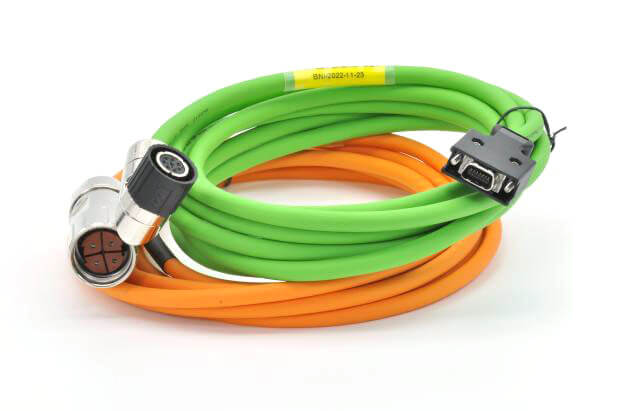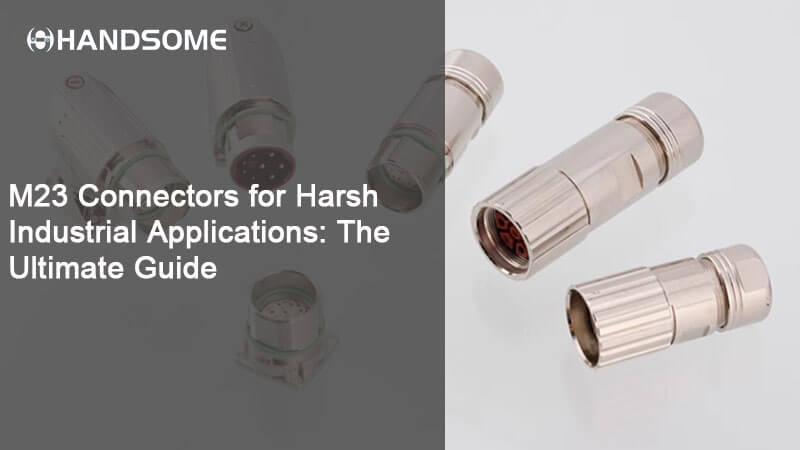Table of Contents
When you’re working in an industrial setting, whether it’s manufacturing, robotics, or renewable energy, the last thing you want to worry about is your connectors failing under tough conditions.
We’ve all been there—choosing the wrong connectors can lead to system downtimes, unexpected costs, and even safety risks. But fear not, because M23 connectors are here to solve many of those challenges.
In this guide, I’ll walk you through everything you need to know about M23 connectors, from their key features to why they’re the best choice for harsh industrial environments.
Trust me, I’ve learned these lessons the hard way, and I’m excited to share the insights I’ve gathered along the way. 
What Are M23 Connectors?
A Brief Overview of M23 Connectors
M23 connectors are a type of circular connector known for their ability to handle power, data, or both in demanding industrial environments.
With a larger size compared to other connectors (around 23mm in diameter), they’re built to withstand extreme temperatures, high voltages, and environmental challenges.
Their robust construction and versatility make them a go-to choice for industries such as robotics, automotive, and manufacturing.
As someone who has spent a lot of time choosing connectors for industrial automation projects, I can tell you that the right M23 connector will provide reliable performance even in the harshest environments.
I recall a project where we needed connectors that could survive intense vibrations in a heavy machinery setup.
The M23 connectors not only held up but also minimized maintenance needs, saving the company both time and money.
Common Applications for M23 Connectors
M23 connectors are used in a wide range of industrial applications, including:
- Robotics: M23 connectors are perfect for powering industrial robotic arms and connecting them to their control systems.
- Motor Control: These connectors can handle high current, making them ideal for motor control systems in machinery.
- Outdoor Equipment: M23 connectors are frequently used in outdoor equipment like construction machinery, agricultural devices, and renewable energy systems.
- Industrial Automation: From automated production lines to conveyors, M23 connectors play a crucial role in keeping everything running smoothly.
Key Features of M23 Connectors
1. High Voltage and Current Capacity
M23 connectors can handle up to 630V and 28A, making them a reliable choice for high-power applications.
I once worked on a robotic system for an automotive manufacturer, and using M23 connectors allowed us to ensure that the robotic arms had the reliable power they needed without any interruptions.
2. Rugged Construction
The connectors’ metal housings offer exceptional resistance to wear, impact, and corrosion.
This is crucial when you’re dealing with environments exposed to extreme conditions. Whether it’s the dust and dirt in a factory or the constant vibrations from heavy machinery, M23 connectors won’t let you down.
3. Wide Temperature Range
With an operating temperature range of -40°C to +125°C, M23 connectors perform reliably across a wide range of temperatures.
This is essential for machinery operating in environments that fluctuate between extreme heat and freezing cold.
During a project in a cold storage facility, these temperature-resistant M23 connectors were instrumental in maintaining uninterrupted performance.
4. IP Ratings
M23 connectors come with high ingress protection ratings, typically ranging from IP65 to IP69.
This makes them water and dust-resistant, perfect for outdoor applications or areas where exposure to moisture is common.
I’ve seen M23 connectors hold up beautifully in outdoor robotics applications, where dust and rain were constant factors.
5. Versatile Pin Configurations
M23 connectors are highly customizable, offering various pin configurations depending on the needs of your application.
They can handle both power and data transmission, which is a huge advantage in complex systems requiring reliable, high-performance connections.
Why Choose M23 Connectors for Harsh Industrial Applications?
Durability in Extreme Environments
One of the biggest reasons to choose M23 connectors is their durability.
Whether you’re in a factory with high levels of vibration or working outdoors where weather conditions are unpredictable, these connectors are built to endure.
I remember working on a manufacturing plant where power surges and harsh chemicals in the air were constantly taking a toll on the connectors.
Once we switched to M23 connectors, we saw a significant reduction in maintenance costs and downtime.
Their rugged construction simply stood up to everything the plant threw at them.
Weather Resistance
If you’re working with outdoor equipment, M23 connectors are built for the job.
With an IP67 rating (and even up to IP69K), they’re completely protected from dust and water, which makes them perfect for applications in the field, like wind turbines, solar panels, or even construction machinery.
In one outdoor robotics project I worked on, we used M23 connectors to ensure that the robot could operate reliably despite rain, mud, and even high humidity.
The performance was outstanding, and we didn’t have to worry about connectivity issues during operation.
Compatibility with Heavy-Duty Equipment
M23 connectors are well-suited for connecting heavy-duty equipment like motors, sensors, and actuators. I’ve seen them used to power robotic arms and conveyor systems, and they’ve never failed to deliver reliable performance in these high-stress environments.
Selecting the Right M23 Connector for Your Needs
Choosing the correct M23 connector isn’t as simple as picking any model off the shelf. Here are some important factors to consider:
A. Power, Signal, or Hybrid Requirements
Before selecting an M23 connector, determine whether your system requires power, signal, or a combination of both. M23 connectors come in different configurations, with some designed specifically for high-power connections, while others are more suited for data transmission.
B. Environmental Conditions
Are your equipment and connectors going to be exposed to extreme heat, moisture, or chemicals? M23 connectors come with different levels of ingress protection, so it’s important to choose one that suits your specific environmental conditions.
C. Connector Type
M23 connectors come in both straight and right-angle designs. Right-angle connectors can save space in tight configurations, while straight connectors might be better for more direct paths. Also, consider whether you need male or female connectors, or if you need to connect multiple cables.
D. Pin Configuration and Cable Compatibility
Consider the pin configuration that best suits your system’s needs. Also, make sure the cables you’re using are compatible with the M23 connector, especially if you’re using shielded cables for signal integrity.
E. Compliance and Certifications
It’s essential to ensure that your M23 connectors comply with relevant industry standards, such as UL, CE, and RoHS compliance, to guarantee safety and quality.
Installation and Maintenance Tips
A. Proper Installation Practices
Proper installation is key to ensuring the longevity of your M23 connectors. Ensure the connectors are firmly seated, and avoid over-tightening, which can lead to damage. In my experience, taking the time to properly install each connector reduces the likelihood of maintenance problems down the road.
B. Routine Maintenance
While M23 connectors are incredibly durable, regular maintenance is still crucial. Inspect the connectors periodically for wear or corrosion, especially in high-vibration environments. Keeping the contacts clean will help maintain optimal performance. I remember replacing a few connectors in a system where dust had accumulated, which was causing intermittent connectivity issues. After cleaning, the system ran smoothly again.
C. Protective Accessories
Consider using protective accessories like sealing caps or grommets, especially for outdoor applications. These accessories can help prevent moisture from entering the connector and prolong its life.
Real-World Applications of M23 Connectors
Factory Automation
In one of the largest automated assembly lines I worked on, M23 connectors were used to power the motors and control signals for robotic arms.
Their ability to handle high current while resisting vibration made them the best choice for keeping the production line running smoothly without interruptions.
Outdoor Robotics
For a project where autonomous robots needed to operate in various weather conditions, M23 connectors were the backbone of the system.
They ensured reliable power connections despite rain, dirt, and mud, making them indispensable for outdoor robotics.
Renewable Energy
M23 connectors are commonly used in solar and wind energy systems. In a solar farm project, they were used to connect inverters and monitoring systems, and they performed flawlessly in extreme weather conditions.
Construction and Mining Equipment
Heavy machinery used in construction and mining also benefits from the durability of M23 connectors.
In these industries, downtime can be costly, and M23 connectors provide the reliability needed to keep everything moving.
Benefits and Limitations of M23 Connectors
Benefits
- High power handling capacity for industrial applications.
- Superior durability and resistance to harsh environments.
- Versatile for various applications, including power, signal, and hybrid systems.
Limitations
- Larger size compared to more compact connectors.
- Higher upfront cost, although this is offset by their longevity and reduced maintenance needs.

Conclusion
M23 connectors are the ultimate choice for harsh industrial applications.
Whether you’re dealing with high power, extreme temperatures, or outdoor environments, M23 connectors can handle it all with ease.
They offer the reliability, durability, and versatility needed to keep your systems running smoothly. By carefully selecting the right M23 connector for your project, you’ll be ensuring long-term success and minimal downtime.
If you’re looking to enhance the reliability of your industrial automation setup, consider investing in high-quality M23 connectors. You’ll be glad you did!
